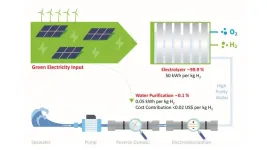(Press-News.org) While human activity has had a massive effect on the natural world, a new study from North Carolina State University finds that climate is still the most influential factor in determining where mammals can thrive. The work sheds light on how climate change will affect wildlife populations.
Roland Kays, lead author of a paper on the work, said the study’s goal was to compare the importance of climate versus human factors in where mammals chose to live. To do so, researchers collected data on 25 mammal species from 6,645 locations across the United States. The study is one of the largest camera trap data analyses ever done. The data came largely from Snapshot USA, which is a national mammal camera trap survey conducted with collaborators across the country.
“One of our ideas was that humans may have changed our landscape so much that we have become the primary determinants of which animals live where,” said Kays, who is a research professor at NC State and scientist at the N.C. Museum of Natural Sciences. “What we found was that in fact humans were not the most important. Climate, including temperature and the amount of rainfall, was the most important factor across most of the species we observed.”
However, human activity in the form of large population centers and agriculture was still a significant factor in where mammals chose to live. Some species struggled in the presence of cities and farms, Kays said, but many thrived.
“There are a lot of species that do well when humans are around. The Eastern gray squirrel for instance is the most common squirrel in Raleigh, and it does great around people. But there’s another species called the Eastern fox squirrel, and that one does well around agriculture but not as well around people,” he said. “We can see those differences in many other species. The snowshoe hare does poorly around both people and around agriculture. This study allows us to see the species that are sensitive to our impacts, and which ones benefit.”
This information helped researchers create maps which predict how common various mammals are across the contiguous U.S., which allowed them to separate the country into regions based on what kinds of mammals were common in each. These regions, known as ecoregions, are commonly used when studying plants but have never before been applied to mammal populations.
“When you look at something like the Eastern deciduous forest, that is an ecoregion classified by how common a type of tree is,” Kays said. “We’re now able to do that with mammal species and then compare that to the plant ecoregions. What we found was a striking similarity between the two. For instance, in the east where there is more rainfall, you have more plants growing. That lined up with a greater abundance of mammals that we saw in that region as well, because more plants mean more food for those animals to eat.”
The open access paper, “Climate, food and humans predict communities of mammals in the United States” is available to read in Diversity and Distributions. In identifying climate as the number one influence on mammal habitat choice, the study presents a new tool for predicting the impacts of climate change on mammal populations. Rising global temperatures will cause shifts in where animals are able to live, as well as influence precipitation levels and plant growth. Understanding these factors will be important to making sustainable decisions about mammal population management in the future.
-pitchford-
Note to Editors: The study abstract follows.
“Climate, food and humans predict communities of mammals in the United States”
Authors: Kays, R., Snider, M. H., Hess, G., Cove, M. V., Jensen, A., Shamon, H., McShea, W. J., Rooney, B., Allen, M. L., Pekins, C. E., Wilmers, C. C., Pendergast, M. E., Green, A. M., Suraci, J., Leslie, M. S., Nasrallah, S., Farkas, D., Jordan, M., Grigione, M., Parsons, A.
Published: June 27, 2024
DOI: 10.1111/ddi.13900
Abstract:
The assembly of species into communities and ecoregions is the result of interacting factors that affect plant and animal distribution and abundance at biogeographic scales. Here, we empirically derive ecoregions for mammals to test whether human disturbance has become more important than climate and habitat resources in structuring communities.
We analyzed data from 25 mammal species recorded by camera traps at 6645 locations across the conterminous United States in a joint modelling framework to estimate relative abundance of each species. We then used a clustering analysis to describe 8 broad and 16 narrow mammal communities.
Climate was the most important predictor of mammal abundance overall, while human population density and agriculture were less important, with mixed effects across species. Seed production by forests also predicted mammal abundance, especially hard-mast tree species. The mammal community maps are similar to those of plants, with an east–west split driven by different dominant species of deer and squirrels. Communities vary along gradients of temperature in the east and precipitation in the west. Most fine-scale mammal community boundaries aligned with established plant ecoregions and were distinguished by the presence of regional specialists or shifts in relative abundance of widespread species. Maps of potential ecosystem services provided by these communities suggest high herbivory in the Rocky Mountains and eastern forests, high invertebrate predation in the subtropical south and greater predation pressure on large vertebrates in the west.
Our results highlight the importance of climate to modern mammals and suggest that climate change will have strong impacts on these communities. Our new empirical approach to recognizing ecoregions has potential to be applied to expanded communities of mammals or other taxa.
END
A new study of over 175,000 people in 25 countries revealed that individuals in low- and middle-income countries face greater challenges with daily activities and are less likely to use assistive devices compared to those in high-income countries. These findings raise concerns about the global burden of disability, particularly in low-income countries.
Despite decreases in death and cardiovascular disease rates and increases in life expectancy worldwide, people in low- and middle-income countries still ...
Researchers at UCLA Health uncovered new information about the role inflammation plays in mitigating liver fibrosis, which is associated with metabolic-associated fatty liver disease (MAFLD), one of the most common diseases in the world affecting up to 40 percent of U.S. adults. While inflammation in the liver has long been considered a prerequisite to developing liver fibrosis, the scarring and thickening of tissue that can impair the liver’s ability to function, this new research suggests ...
From July 30-31, Alex Zhavoronkov, PhD, founder and co-CEO of clinical stage artificial intelligence (AI)-driven drug discovery company Insilico Medicine will be attending SCRI Clinical Trials Symposium 2024 at Raffles City Convention Centre, and Brainstorm AI 2024: The New Race for AI at The Ritz-Carlton, Millenia Singapore, sharing strategic insights with global leaders across the technology and healthcare industries.
On 2:00 p.m, July 31, Alex Zhavoronkov PhD will be speaking at the session named “Methodologies and Considerations for ...
Writing research papers is critical for disseminating scientific findings, but it does come with efficiency burdens, particularly for early-career researchers and non-native English speakers. A survey published in Nature in 2018 indicated that approximately 37% of respondents reported that they spend more than 20 hours a week on writing and revising scientific papers.
Recent progress in Natural Language Processing (NLP) technology, particularly with the rise of Generative Pre-trained Transformers (GPT) and other Large Language Models (LLMs), has equipped researchers with a powerful set of tools for processing extensive amounts of literature ...
As 5G technologies continue to evolve, scientists and engineers are already exploring new ways to turn things up a notch for 6G. One of the biggest challenges to address in both 5G and 6G is the many detrimental effects that operating at extremely high frequencies has on wireless communications. At frequencies nearing the terahertz range, problems such as signal attenuation and interference are more prominent, and maintaining signal integrity becomes much harder.
Some of these issues can be greatly mitigated by using insulating materials with exceptional dielectric properties. Glass- and ceramic-based insulating materials ...
At first glance, the plan sounds compelling: invent and develop future electrolysers capable of producing hydrogen directly from unpurified seawater. But a closer look reveals that such direct seawater electrolysers would require years of high-end research. And what is more: DSE electrolyzers are not even necessary - a simple desalination process is sufficient to prepare seawater for conventional electrolyzers. In a commentary in Joule, international experts compare the costs and benefits of the different approaches and come to a clear recommendation.
Fresh water is a limited ...
New research has found that 4,642 species of vertebrate are threatened by mineral extraction around the world through mining and quarrying, and drilling for oil and gas.
Mining activity coincides with the world's most valuable biodiversity hotspots, which contain a hyper-diversity of species and unique habitats found nowhere else on Earth.
The biggest risk to species comes from mining for materials fundamental to our transition to clean energy, such as lithium and cobalt – both essential components of solar ...
About The Study: U.S. health care workers are more likely than other workers to carry medical and educational debt, collectively owing more than $150 billion. This study found that medical debt was more prevalent among women, home health and nursing home personnel, uninsured individuals, and those with recent hospitalization. Educational debts disproportionately burdened Black workers and younger workers and those with higher education.
Corresponding Author: To contact the corresponding author, Kathryn E.W. Himmelstein, M.D., M.S.Ed., email khimmelstein@mgb.org.
To access the embargoed study: Visit our For The Media website at this ...
About The Study: This cross-sectional study indicates that stringent COVID-19 restrictions, as a group, were associated with substantial decreases in pandemic mortality, with behavior changes plausibly serving as an important explanatory mechanism. These findings do not support the views that COVID-19 restrictions were ineffective. However, not all restrictions were equally effective; some, such as school closings, likely provided minimal benefit while imposing substantial cost.
Corresponding Author: To contact the corresponding author, Christopher J. Ruhm, Ph.D., email ruhm@virginia.edu.
To access the embargoed study: Visit our For The Media website ...
About The Study: In this survey study of 5,991 participants, presumptive posttraumatic stress disorder (PTSD) was quite prevalent long after the mass violence incident (MVI) among adults in communities that have experienced an MVI, suggesting that MVIs have persistent and pervasive public health impacts on communities, particularly among those with prior exposure to physical or sexual assault and other potentially traumatic events. Focusing exclusively on direct exposure to MVIs is not sufficient. Incorporating these findings into ...




